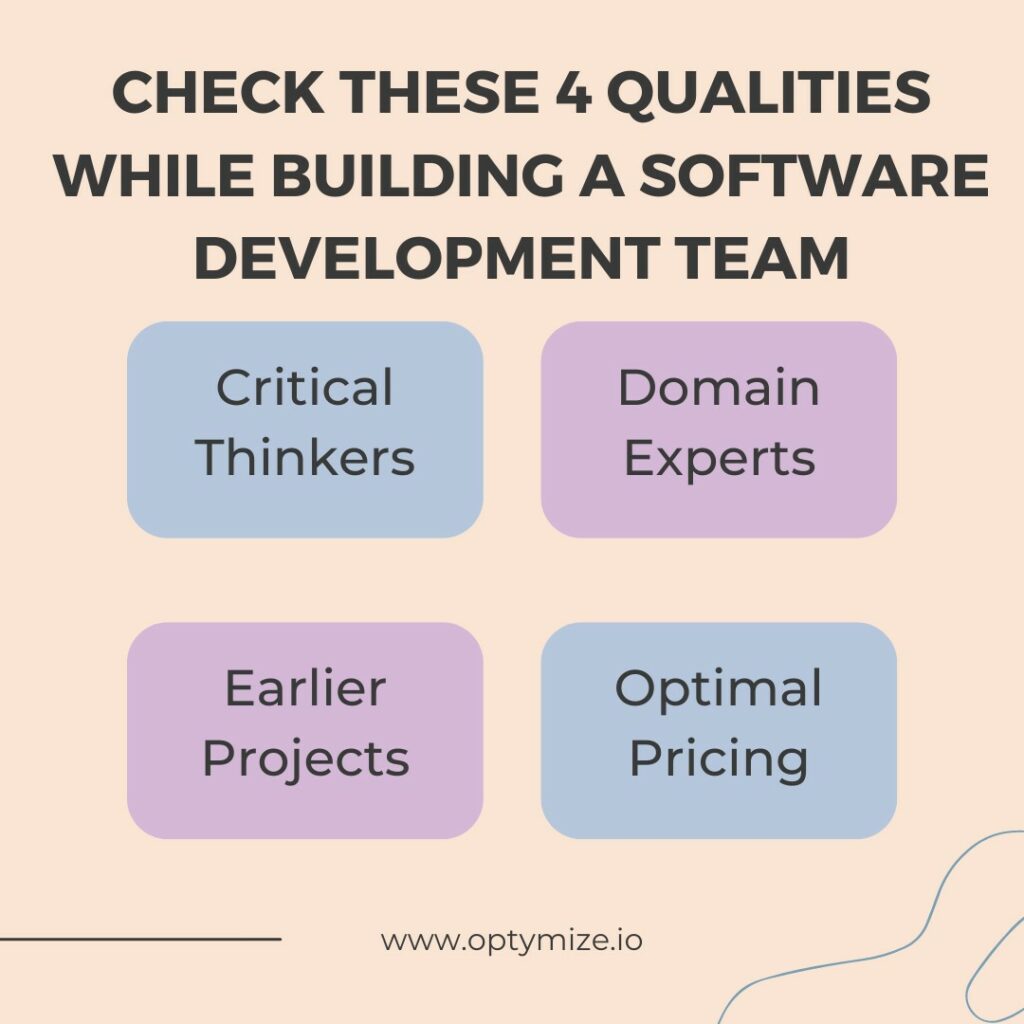You don’t get a productive software development team. You build one.
Many companies frequently picture a self-managed software development team. They think of committing wholly to their work while trying to develop the next big product.
Truth is, building a productive software development team is more difficult than it first appears to be. When team members are confident that they can accomplish shared objectives. That confidence in solving a problem is what sets a great software developer apart from a good one.
Many startups and businesses face a lack of individual and group confidence in the project’s success. Low confidence contributes to the early failure of the majority of development projects. Up to 66% of IT experts express a lack of knowledge of project requirements.
You’ll learn about tried-and-tested methods and industry-recognized best practices for creating a productive software development team in this article, from hiring the best candidates to using project management strategies. Let’s Begin.
What Is A Software Development Team?
A software development team consists of developers, managers, analysts and other professionals. They collaborate to create a technical project or product. Each member of the development team contributes and is responsible for their work.
The most important qualities of a software development team are cross-functional and self-organizing. If the developers are organized at the individual level then the effectiveness of the development team can be maximized.
The team members must work together and make collaborative efforts to effectively communicate, and carry out respective tasks and shared responsibilities.
It is critical for the product development teams to have some qualities. Those qualities are helpful to achieving harmony of team structure and empowerment:
- i) The product development team organizes itself naturally and each one of the team members provides effort to ensure productivity.
- ii) The team should have all the abilities required to advance product development through all stages of development. To achieve this the team should be cross-functional, and well-equipped.
- iii) All the team members of the development team have specialized skills and different areas of focus. And they should bear responsibility for each other as a whole.
The successful team members perform the following tasks and successfully develop the project/product.
- i) Organizes the codebase and makes it readable.
- ii) They are familiar with the wants and interests of their customers.
- iii) They criticize ideas and find solutions for them if any.
- iv) They offer insights by sharing past experiences to offer more knowledge and perspectives.
- v) Most importantly, have a friendly nature with each of the team members.
What Are The Software Development Team Roles?
A software development team consists of many members and each of them has a different role. Some of the most common job titles in the product development team are:
- Business Unit Manager
- Product Manager
- Business Analyst
- Project Manager
- Technical Lead
- Developer
- UI/ UX Designer
- Quality Assurance Engineer / Product Tester
What are the Responsibilities of a Software Development Team Member?
In a product management team, it is essential to define the overall responsibilities in detail. It will lead to efficient development.
Here are the roles and their key responsibilities for any software development team in terms of business and technology.
1. Business Unit Manager
A business unit manager acts as a task manager. They manage the set goals and contribute to the success of the company.
Their responsibilities are:
- Initiating a project with resources
- Share the project vision with Teammates
- Have a strategy to solve all issues in time
- Share the milestones and keep up the work.
2. Product Manager
Many startups use business unit managers and product managers interchangeably. But they have some key differences. It is important to differentiate between these two roles.
A product manager is in charge of ensuring the success of a single product. They do not manage like a business unit manager.
Responsibilities of a product manager are:
- Transform the vision of a product into a roadmap.
- Define features of a specific product
- Ensure the development is going on towards success.
3. Business Analyst
The job of a business analyst is to act and connect the dots between technical development and the business side of a company. They create reports from data from both sides to advocate the success of a company.
Sometimes business analysts will collaborate with product managers and business development officers. They will work together to define the features of a product and how to refine and to resolve all the technical issues. Those reports by business analysts will ensure if the product is developed or not.
Responsibilities of Business analysts:
- Clarify the refined and enhanced features of the product.
- Ensure the development according to business requirements.
4. Project Manager
Project managers are similar to business managers but on the technical level. They ensure the team is using the resources properly to deliver the perfect product on time.
A project manager is in charge of the following tasks:
- Schedule and host meetings on project development.
- Provide the resources required to develop the project properly.
- Watch over the team and its performance
- Offer constructive feedback and helpful suggestions
5. Technical Lead
A technical lead acts as the key point of contact for project managers and business analysts.
They manage the issues between software development and business management. They act as a moderator and steer the technical direction of the company.
Their roles are:
- Responsible for the entire technical project
- Implement best procedures for development
- Keep a detailed structure of the project and its requirements.
6. Developer
Developers are the core members of a software development team. Their performance and problem-solving abilities directly impact product development pace.
They spent their time by:
- Developing and deploying updates
- Provides updates of progress to project manager and technical lead
7. UI/ UX Designer
These designers are an integral part of the team. They design the products and developers implement them.
A UX designer is responsible for designing the behavior of a product. On the other hand, UI designers work on the layout and graphical designs of the product.
Their responsibilities are:
- Collaborate with the product manager to meet the expectation and requirements of customers of the product
- Collaborate with the team during the development phase.
8. Quality Assurance Engineer
A quality assurance engineer tests the product with certain factors to check if the state of the product is good. A QA engineer will greenlight a project or product for release based on the result of the test.
Their key responsibilities are:
- Check the product conditions
- Check if the defined criteria and requirements are satisfying
- Engage with the team and guide the team to develop a quality product
Software Development Team Structure
The following figure will clarify the hierarchy of a Software Development team.

Software Development Team Size
A software Development team size varies according to the project requirement. A team may include a QA tester or not and that will depend on the budget of the project. If the project cost is higher than for smooth functioning the team needs to have many members with particular tasks. According to agile software development, a team needs to have 3-9 members.
Check These 4 Qualities While Building A Software Development Team
Running a business demands choosing the right option among hundreds. Likewise, building the right software development team for your business can be overwhelming. The successful completion of your project/products and the future of your business will depend on the team you build.
Assemble a team who will act as more than an employee. They must collaborate to develop the product at a defined pace. This team has the capability of bringing your vision to life.
Some questions that you can ask yourself are:
- Do I know the roles of the software development team that I am building?
- Am I going to manage them or need to hire one manager?
- How many developers will my project require?
We do not build a software development team for a month. The team can go on and work for years. But to last that long, the team members should be compatible with each other.
The following are the 4 qualities you should check before hiring for your product development team.

1. Analytical Thinkers
- Every software team manager wants to pick a product development team that can give them the best solution and the most effective means of achieving it.
- On the way, a situation may arise where the team doesn’t agree with your original ideas. However, refusing something can sometimes be more effective than saying “yes.” It shows a willingness to look for the best answer rather than just blindly following the directions.
2. Domain Experts
- Writing code is only one step in a complex process that goes into every software development project. Your software development team must be able to balance the needs of the end-user with those of the business.
- Look for professionals with strong backgrounds in their fields who can contribute their knowledge when it matters the most.
3. Previous Projects
- The quality of the work that prospective team members have produced in the past is a good indication of their abilities. You can see the clients they worked with and how they completed the project to address the issue at hand.
- Always check the references of the potential team members. Case studies, summaries of completed projects, and any other information you might need to make a decision are all readily available from seasoned IT companies.
4. Optimal Pricing
- Choosing the cheapest offer doesn’t always work out. High-quality work demands high cost and cheap offers can affect the quality of the work.
- Some of the bad outcomes of cheap offers are poor communication, a lack of experience, poorly written code, a lack of tests, and poor documentation.
- The cost of custom software development projects is more than commercially available software. But they are better investments because of the advantages they produce.
Top 8 Steps To Build And Manage A Profitable Software Development Team
The key point to build and manage a software development team is to take an active part in all the steps. Here we will talk about eight steps related to building a perfect and profitable product team.
1. Look After The Hiring Process
In this step, you must ensure to target the perfect candidates for the role. To target the required candidates you must take notice of the following steps.
- Describe the job and the performance it will require rather than explaining skills and experiences.
- Define a few objectives to measure the candidate’s expertise.
- Use the objectives for the recruitment scheme.
- Post the job ad with a compelling tagline.
- Sort through the resumes of interested candidates.
- Perform a smooth interview process.
- Onboard the candidates and explain the job.
2. Always Hire Passionate Candidates
Target the developers who enjoy coding and like to create profitable products. Many developers work in the software development industry because it pays well. So it is better to examine the candidates thoroughly about their past experiences and projects.
3. Promote Soft Skills Among the Team
A software development team requires people with soft skills. Focusing only on technical skills might hamper the management of the team.
- Build a communicative and respectful team.
- Notice the soft skills and cultural fit during the hiring process.
- Choose the best candidates suited for collaborative projects.
- Promote cross-functional teams to stay competitive.
- Provide opportunities for the team to learn and grow together.
- Allow the team members to recognise the strengths and weaknesses of each other and perform their jobs accordingly.
4. Equip The Team With Proper Tools And A Good Environment
- Tools are the key point of a collaborative team.
- Provide them with a good environment to work and utilize those tools to the fullest.
- A Good work environment creates less stress and brings productivity.
5. Promote Active Listening and Communication
Communication is a two-way process. The whole team should ask and listen to questions and answers respectively.
Some of the key questions to ask are:
- What is the timeline of your task?
- What is your constructive feedback on the issue?
- What are you working on currently?
- Please provide the latest update on your task.
6. Set Goals to Improve Team Communication
Smooth communication is not about asking questions and listening to replies. To ensure smooth communication encourage the following steps:
- It is important to define each role and goal of the team members.
- Discuss the various roles and the performance each of those roles will require.
- Motivate team members to ask questions.
- Tell the team to calm down when there’s some mistake.
- Ask for constructive feedback from the team members.
7. Create Profitable Software
Regardless of the technical and business requirements, if users love your software, team members will have that extra motivation to keep improving it.
Creating software is not enough. You have to push the team to create software that will fulfil technical and business requirements. But more than that you should motivate the team to create software that people will love and enjoy. That will ultimately lead to profit.
8. Choose to Hire Remotely
Many businesses are nowadays turning towards remote hiring. Because remote work provides benefits for both the team members and the company. Choosing remote hiring will provide the following benefits:
- More Productivity
- Save hiring budget
- Avoid commuting
- Access the global talent pool
- High Profit
Software Development Team Best Practices
Provide the team with the right tools/software
Promote a smooth development process right from hiring the candidates for a particular role.
As a manager, it is crucial to manage the progress, and performance and document them for better productivity.
Set straight and easy goals and priorities for the team members.
Conclusion
Putting together an ideal software development team has become more crucial, because of the constant and modern requirements for software and product development.
You can expedite your projects and increase productivity by following the above steps with a carefully selected team of technical professionals for software development.
Optymize offers remote engineers at your convenience. If you want to scale your software development team then contact us and hire your perfect remote engineer and build a profitable software development team.







